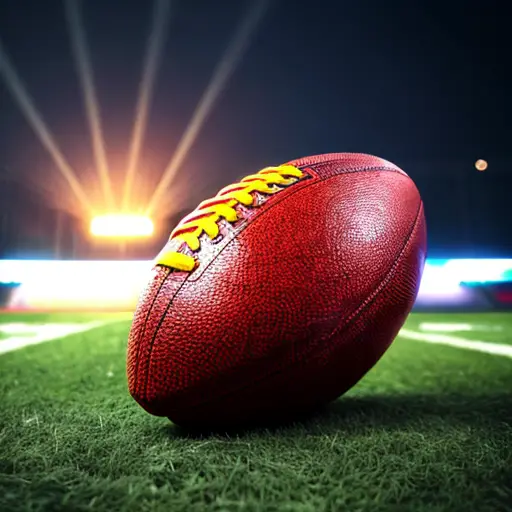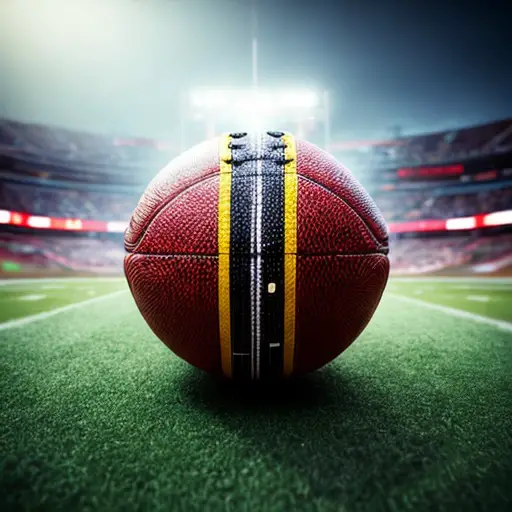How Large is an American Football Ball?
The Anatomy of an American Football Ball: Materials and Dimensions Explained
Ah, the mysterious and beloved American football ball. Don’t let its Magnificent-Pumpkin-Of-Fun appearance fool you, there’s more to it than meets the eye. So, just how big is an American football ball? Well, my dear readers, prepare to have your minds blown by the incredible dimensions of this pigskin marvel. Picture this: imagine trying to wrap your hands around a small asteroid orbiting the gridiron, about a foot long and roughly the weight of a compact car. Yes, my friends, American football balls are carefully crafted with leather, stitching, and a hefty dose of intimidation. It’s the perfect size for quarterbacks to hurl like a cannonball and wide receivers to finesse into their cradled arms. So, next time you watch a game, ponder the gigantic glory of that oddly-shaped, turbine-engine-sounding projectile soaring through the air.
The Evolution of American Football Balls: From Pigskins to Synthetic Materials
An interesting fact about the size of an American football ball is that it actually has different dimensions depending on the level of play. In professional football, the standard size is approximately 11 inches long and about 22 inches in circumference at its widest point. However, college and high school footballs tend to be slightly smaller, with an average length of around 10.5 inches. Additionally, footballs used in youth leagues are even smaller, ranging from 9 to 9.25 inches in length.
Ah, the evolution of American football balls, a fascinating journey indeed! From the good ol’ days when pigskins did, in fact, refer to actual pig skins, to the modern era where synthetic materials reign supreme. But let’s address the burning question: just how big is an American football ball? Well, my friends, let me tell you, it’s like holding a small universe in your hands! Okay, maybe not that big, but close! Picture a majestic orb, somewhere between the size of a cantaloupe and a watermelon, designed to be the perfect blend of grip and aerodynamics. So, next time you watch a game and wonder about the size of that ball, remember, it’s not a watermelon, but it sure packs a punch!
Understanding the Standard Size and Weight of American Football Balls

Ah, the American football ball. That oblong, peculiarly shaped object that captivates and confuses us all. Just how big is it, you ask? Well, let me enlighten you, my fellow football enthusiasts, with a dash of humor and a generous sprinkling of absurdity.
Firstly, let’s address the size question. The standard American football ball, affectionately known as the ‘pigskin’ due to its close resemblance to the hide of an actual pig, measures roughly 11 inches from tip to tip. Yes, my friends, we’re talking about a mighty impressive span that would make any average-sized ruler quake in its measly centimeters. Watching a quarterback hurl this rotund miracle through the air, dodging defenders like a sneaky ghost, is enough to make you appreciate the sheer colossal size of this delightful game accessory.
But wait, there’s more! We cannot forget to ponder the weight of this extraordinary ball. Picture, if you will, a tiny universe encapsulated within its tough, leathery exterior. This orb of sporting excellence, brimming with hopes and dreams, weighs a not-so-featherlight 14 to 15 ounces. To put it into perspective, my dear readers, that’s approximately the same weight as your average can of beans or that tub of expired yogurt you still secretly hoard at the back of your refrigerator. Imagine your favorite football heroes sprinting, evading tackles, and leaping into the air while clutching this hefty burden with the grace of a majestic unicorn. It’s truly a sight to behold.
Now, let’s explore the absurdity. As if the size and weight weren’t quirk enough, let’s delve into the history that birthed this madness. You see, dear readers, the shape of the American football ball didn’t arise from years of scientific precision or meticulous design. Oh no, it originated as a mere happy accident. Legend has it that the original footballs were made by inflating pig bladders. Yes, you heard me right – we owe our beloved sport to a bizarre combination of pig organs and human curiosity. Thankfully, modern technology has since spared the world from the phantasmagorical horrors of playing with actual pig organs, replacing them with an equally peculiar leather casing. Thus, the tradition of tossing around a grotesquely shaped spheroid has endured, forging a bond between players, fans, and the occasional pig enthusiast.
So, my friends, the answer to the million-dollar question is clear – American football balls are, quite simply, a peculiar mix of magnificent size, commanding weight, and a dash of whimsical absurdity. The next time you behold the glories of this extraordinary sport, remember to appreciate the wonder of the ball itself. Give a little nod to the brave souls who fling it through the air, dodge defenders with grace, and create a spectacle that entrances millions. And in the spirit of the game, let us all raise a glass (or a can of soda, if you will) to the humble pig, whose anatomy has inadverttently brought us so much joy. Cheers to you, oh mighty pigskin!
The Importance of Ball Size in American Football: Implications for Gameplay and Performance
An American football ball is approximately 11 inches long, making it shorter than a foot-long sub sandwich, but definitely not as tasty!
Ah, the age-old question that has puzzled both football enthusiasts and accidental spectators alike – just how big is an American football ball? Many believe that the answer holds great significance for gameplay and performance. Picture this: a massive ball floating above the field, ready to be caught like a wild beast tamed by seasoned wide receivers. Would it make the game more thrilling or utterly chaotic? Would quarterbacks find themselves buried beneath humongous pigskins, struggling to throw passes? Would goalposts require reinforcements to withstand the gargantuan projectiles flying their way? These peculiar scenarios may seem far-fetched, but when it comes to ball size in American football, we must ponder the implications beyond mere dimensions. So, dear readers, grab your tape measures, for the fate of the gridiron lies in the hands of… well, rather large balls.
Charlie is not your average man blogger. With a quick wit and a knack for finding humor in the most unexpected places, he brings a refreshing twist to the world of American football. Armed with his keyboard and a passion for the game, Charlie dives deep into the intricacies of the sport, dissecting plays, analyzing strategies, and sharing his unique perspective with his readers. Whether he's poking fun at the overzealous fans or cracking jokes about the players' pre-game rituals, Charlie's writing is guaranteed to leave you in stitches while still providing insightful commentary on the game he loves.









